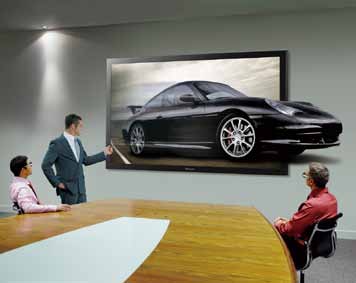Hitachi is vying to beat this with its new HD display technology, which will hopefully enter the market around October. Hitachi Display’s latest is an 11.4cm (4.5-inch) in-plane switching (IPS) LCD with a whopping resolution of 1280×720 pixels. The display also promises a 329ppi density, which is higher than Apple’s most recent 326 ppi. It is LED-backlit and has a contrast ratio of 1100:1.
Lots more happening. Research teams all over the world are attempting to advance HD technology for use in a variety of devices ranging from television sets and monitors to digital signage and mobile phones.
One recent technology developed by a University of Michigan team features pixels that are eight times smaller than those used by iPhone4. The new colour filter used by them is made of nano-thin metal sheets with precisely-spaced gatings. These gatings trap and transmit light of a particular colour as they are sliced into metal-dielectric-metal stacks.
Jay Guo, an associate professor at the university’s department of electrical engineering and computer science, says, “Amazingly, we found that even a few slits can already produce well-defined colour, which shows its potential for extremely high-resolution display and spectral imaging.” He goes on to explain that only about 5 per cent of the backlight from conventional LCDs actually reaches the human eye. This is because in addition to the LCD layer, current technologies use two layers of polariser, a colour filter sheet and two layers of glass laced with electrodes. The new technology, on the other hand, has fewer layers because the colour filter acts as the polariser as well. This will not only improve the image quality but also reduce the manufacturing cost.
The patent-pending ultra-high-definition technology can be used for projection displays, compact screens, bendable screens and military applications.

3D is the future
If HD is today’s revolution, 3D is going to be tomorrow’s. There appear to be a slew of 3D products—3D televisions, 3D monitors, 3D video games, 3D movies, 3D glasses and even 3D goggles that add a third dimension to games you play on your iPhone or iPod—slowly popping up on store shelves globally, though very few are visible in the Indian market yet. 3D TVs are leading the pack.
Today’s 3D displays are mainly stereoscopic models that alternately telecast images meant for the left and right eye, stored in the even and odd fields, respectively, of the video signal. Or a shutter glass worn by the viewer alternately shuts off each eye, so that the eye sees only the video stream meant for it. The brain then follows its natural process of merging the two streams of data to present a 3D view to the user, just as it would merge the views of the right and left eye when we see a scene around us naturally.
While this was the basic technology behind 3D movies we saw decades ago, it has now come to our living rooms, thanks to the advanced display technology, lighter and stylish shutter glasses, and more capable broadcast techniques.
LED models, plasma models, special cameras for easy shooting of 3D content, real-time 2D-to-3D converters and more such technologies are coming up. Auto-stereoscopic models which do not require glasses, are also expected in the future. In fact, mobile phone makers such as NTT DoCoMo, LG and HTC have already introduced devices that feature glassless 3D displays.
However, due to high price tags and insufficient content, 3D products are yet to catch up in India.
material miscellany
Experiences like multi-touch, high-definition and 3D aren’t possible without significant contribution from basic sciences such as optics and materials science. There are several new developments on this front. One is the emergence of organic light-emitting diodes (OLEDs) as a strong contender. Barring a few issues that need to be ironed out before mass adoption, this technology is almost there. Another interesting trend is the renewed interest in surface-emissive displays (SEDs). Apart from these main trends, there are several smaller developments taking place.
“Materials science technology influences both the displays and their controllers. One of the recent innovations in material science is the high-speed phosphor (HSP)—a new technology that Prysm is actively involved in developing. HSP technology is efficiently driven by the solid-state lighting industry. On the other hand, the semiconductor industry is moving towards the next-generation 28nm technology process—a high-performance, low-power process using low-K dielectric materials—jointly developed by Taiwan Semiconductor Manufacturing Company and Xilinx engineers. This will be very important for future display technologies as it combines high performance with low power,” says Mastakar.






